Recent Articles
Popular Makes
Body Types
2018 Lamborghini Huracan Road Test and Review
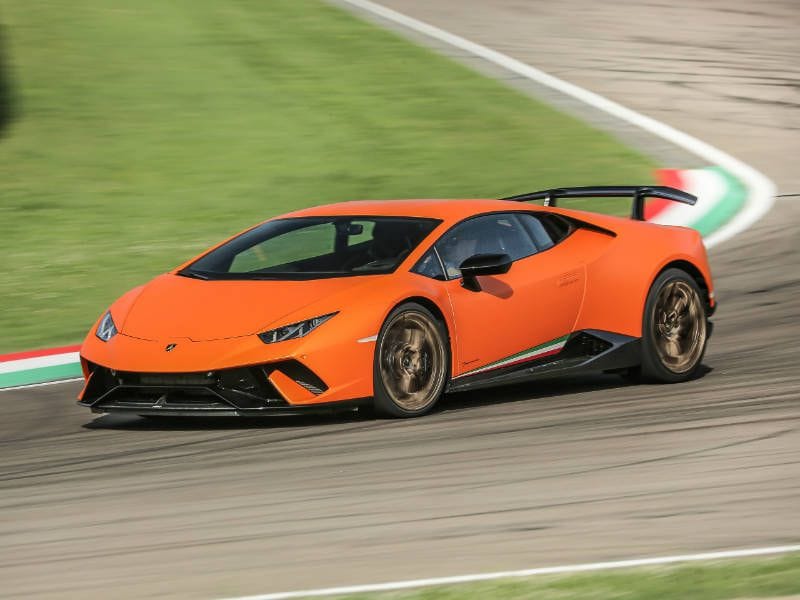
2018 Lamborghini Huracan Performante on track ・ Photo by Lamborghini
201 mph. According to Alessandro Farmeschi, the COO of Lamborghini North America, that’s the top speed of the 2018 Lamborghini Huracan. This is important. When you’re spending over $200,000 on an exotic sports car, it better have a terminal velocity over 200 mph if you’re to get any respect at the local Cars and Coffee. Although Lamborghini is owned by Volkswagen, the new Huracan is designed and built in Italy. It’s one of the fastest, most exclusive vehicles on the road and it competes with a handful of other mid-engine supercars such as the Ferrari 488, the Audi R8, the BMW i8 hybrid and an assortment of McLarens including the new 720S. To fend off those desirable competitors, the Huracan lineup has been fortified for 2018 by a new lighter and more powerful model with a long list of mechanical and design improvements. Let's take a closer look that this icon of Italian engineering and performance.
Coupe or Convertible
Available as a two-seat coupe or convertible, the 2018 Huracan lineup starts with the 573-horsepower rear-wheel drive coupe, priced from around $200,000. Lamborghini says it can accelerate from 0-62 mph in 3.4 seconds. The heavier convertible, or Spyder, can hit 62 mph in 3.6 seconds and it costs quite a bit more: over $262,000. All-wheel drive has been a big part of Lamborghini’s appeal since the 1990s, and it improves the performance of the Huracan. All-wheel drive models are also more powerful, with 602 hp. Lambo says the Spyder can sprint to 62 mph in 3.4 seconds, and the lighter coupe is even quicker with a 3.2-second performance. Prices start around $240,000 for the hardtop. All models are powered by an all-aluminum, double overhead cam, naturally aspirated 5.2-liter V10 engine backed by a seven-speed dual clutch automatic transmission. Other standard speed equipment includes massive brakes, 20-inch aluminum wheels and ultra-wide high-performance Pirelli tires.
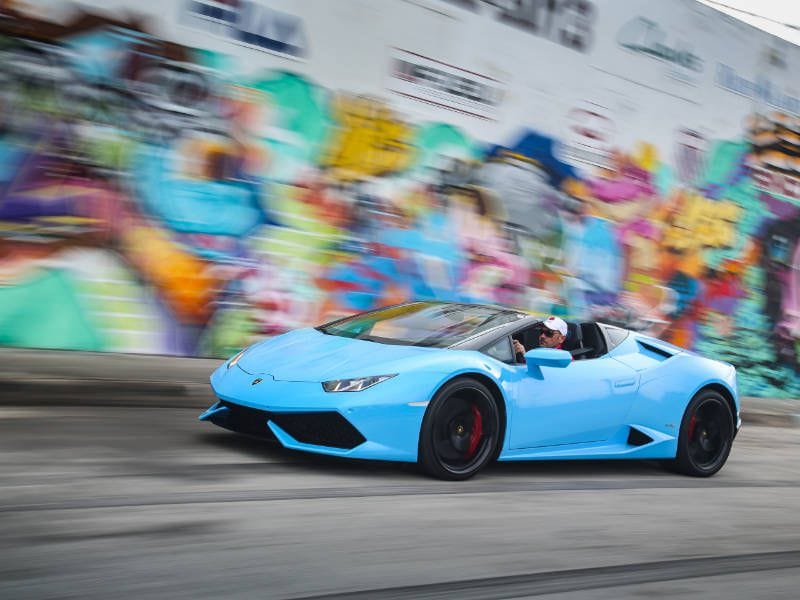
Photo by Lamborghini
Huracan Performante
If you want more speed, style and street cred, step up the new 2018 Huracan Performante like our test vehicle. It’s not only the best-performing version of the Huracan — it’s the best-performing Lamborghini ever. Lighter and more powerful than a standard Huracan, a Performante just set the new production-car lap record around Germany’s famed Nürburgring Nordschleife racetrack. It lapped the 13-mile track in 6 minutes, 52.1 seconds — 35 seconds quicker than the standard Huracan. And Lambo says it can accelerate from 0-62 mph in 2.9 seconds, which is as quick as the company’s V12-powered Aventador S. Prices for the Huracan Performante start at $274,390 and it’s only available in as a coupe, although a Spyder version is expected to appear next year.
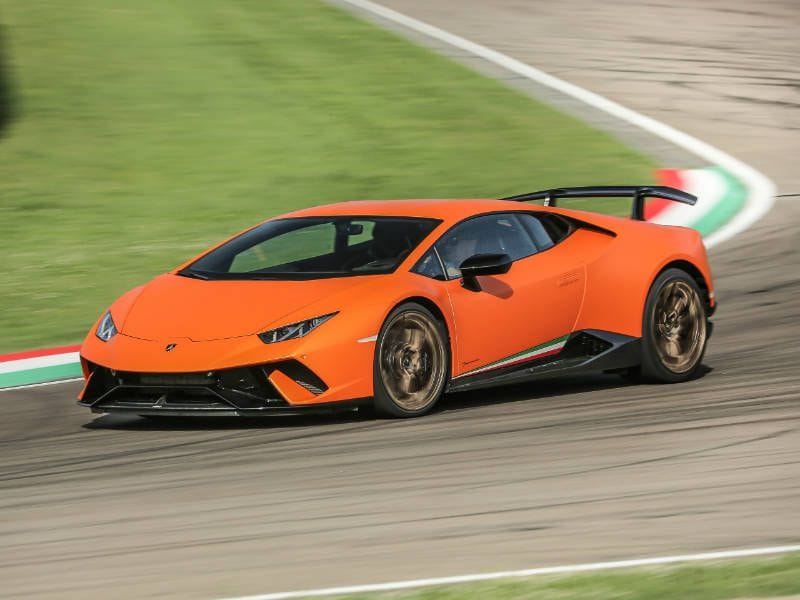
Photo by Lamborghini
No Turbos, Just 640 Horsepower
In this era of turbochargers and electrified hybrids, the Huracan’s big naturally aspirated V10 is downright prehistoric. We love it anyway. In the Performante it has been dialed up to 640 hp at 8,000 rpm and 442 lb-ft of torque at 6,500 rpm. That's an increase of 38 hp over the standard all-wheel drive model, and the additional power is all above 6,000 rpm. The engine still revs out to a stratospheric 8,500 rpm. The Performante is also 88 lbs lighter than the standard Huracan coupe, thanks to a lighter exhaust system and a new material Lamborghini calls Forged Composite. It’s sort of like carbon fiber 2.0, consisting of chopped fibers embedded in a matrix of resins. It’s all over the Performante, both inside and out — it makes up the massive rear spoiler, rear bumper and diffuser, front spoiler and engine cover, which weighs 21% less than the piece it replaced. Inside you see more Forged Composite on the dash, doors and console.
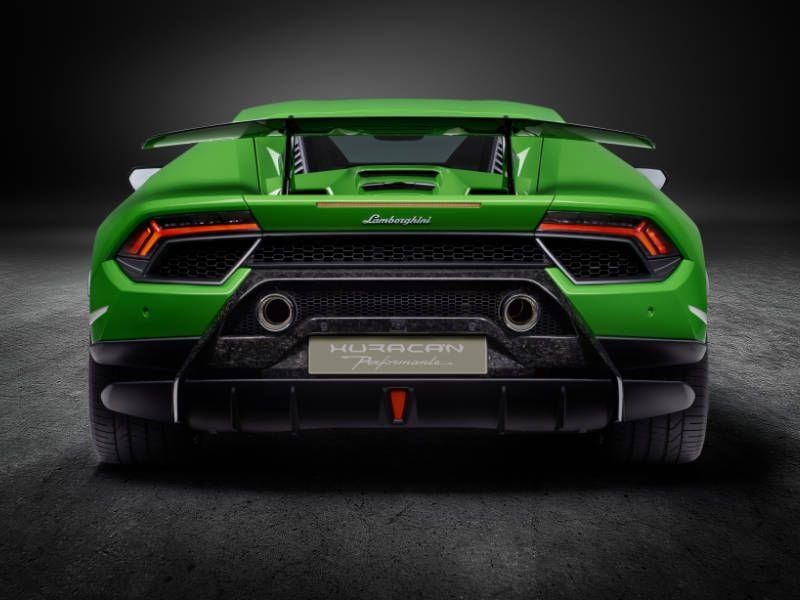
Photo by Lamborghini
Finely Crafted Interior
Lamborghini’s interiors used to be torture chambers with shoddy construction and the seat comfort of a medieval rack. Those days are long gone. The 2018 Huracan is finely crafted with exceptional interior build quality, and the materials are proper for the supercar’s lofty price point. The dash design is simple and clean, but also clever and intricate with few buttons and a 12.3-inch configurable instrument cluster — a display screen for digitally rendered gauges along with the navigation system and other information. The engine's start button is right out of a fighter jet and gauges are labeled in Italian: Olio, Batteria, Acqua and Benzine. Unfortunately, the Huracan’s paddle shifters are mounted to the steering column and not the suede flat-bottomed wheel.
It’s also easy to get comfortable. The seat is firm and heavily bolstered, but supportive and nicely sized. It’s also adjustable for height and the steering wheel tilts and telescopes, so it’s easy to find the right driving position. Meanwhile, convertible models can drop their tops in just 17 seconds.
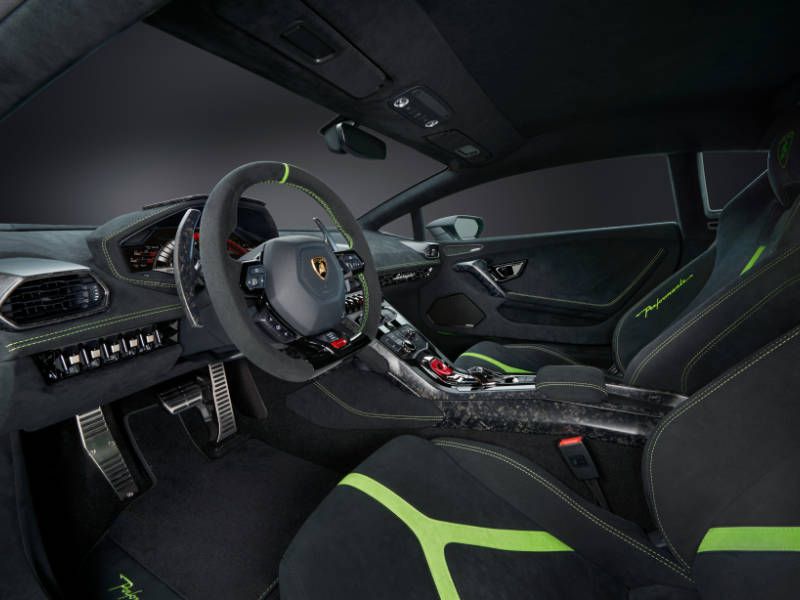
Photo by Lamborghini
No Lamborghini Doors
Lamborghinis are most famous for their unique scissor doors, which open up instead of out. They debuted on the Countach in 1974 and they’re still part of the appeal of the automaker’s more expensive Aventador model. The Huracan’s conventional doors do detract from this supercar’s drama. Some may also be surprised by the Huracan’s compact size. This car looks larger in photos than it really is. But there’s no mistaking its ability to turn heads. People notice when you drive by in a Huracan, and when you stop they ask you about it. And they take pictures with their phones. The presence of a Performante is even more imposing with its huge rear spoiler and the red, white and green stripes that run along the bottom of its doors.
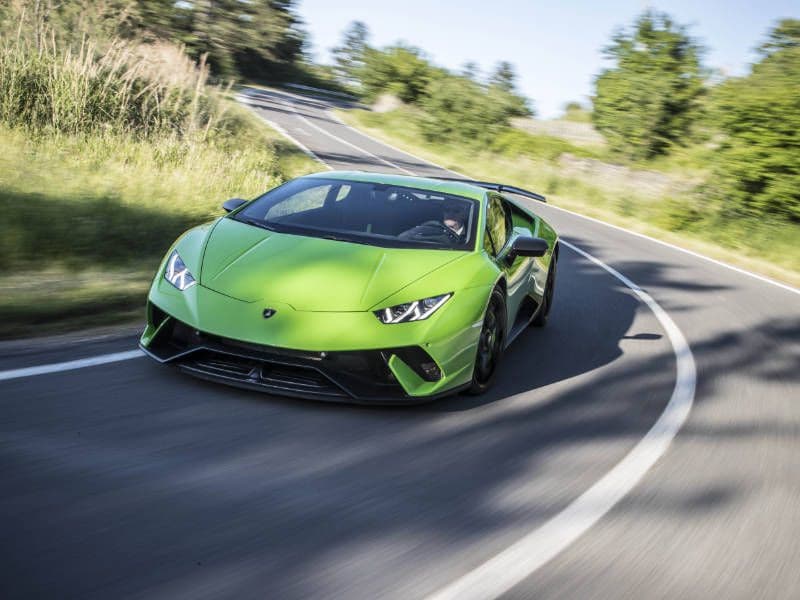
Photo by Lamborghini
Fast, Fun and Forgiving
Out on the racetrack, the Huracan Performante feels small and light. It’s incredibly easy to drive, and its combination of all-wheel drive, stability control and an impossibly low center of gravity can make me look like a talented race car driver. Although the Performante’s suspension has been tuned 10% stiffer for increased performance, it’s compliant over the track’s tall curbing and the overall ride remains refined. In high-speed corners, the Huracan understeers just enough to keep you out of trouble — but it’s tossable and it will drift if you chuck it in and get back on the power quickly. The Huracan’s massive cross-drilled carbon ceramic brakes are some of the best in the world, heat-resistant even after constant lapping on a 100-degree day. Down the straightaways, we touch sixth gear and 140 mph, enjoying the upper-rpm power and the shrieking wail of the big V10. We also appreciated the smooth and quick gearchanges from the Lambo’s dual-clutch seven-speed transmission, which is geared perfectly to keep the engine above 6,000 rpm.
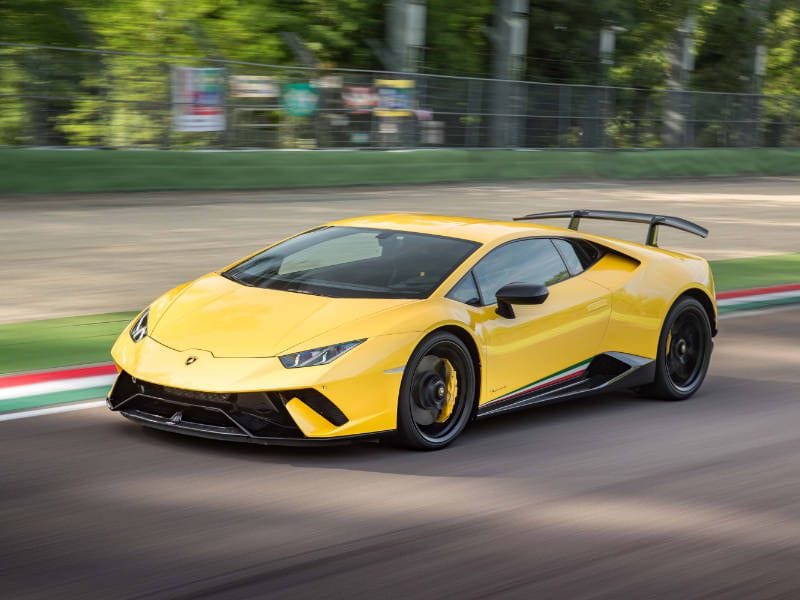
Photo by Lamborghini
Active Aerodynamics
One of the reasons the Huracan Performante is so easy to drive so quickly is its new active aerodynamics system. Officially called Aerodinamica Lamborghini Attiva, the patented and fully automatic system opens and closes flaps in the front spoiler and ducts connected to inner channels of the rear wing as conditions warrant. When the flap is closed, the front spoiler creates downforce for improved high-speed cornering and full brake conditions. When the small electric motor opens the flaps, which takes just .2 seconds, it redirects the airflow under the car — reducing drag and thereby increasing acceleration and top speed. Nail the gas pedal to the carpet and ALA also opens flaps that route air through the rear wing’s inner channels, further reducing drag. But here’s the part that will wow them at the Cars and Coffee: The air channel is split left and right, and the flaps work independently, allowing aero vectoring for high-speed cornering. The ALA system can increase downforce and traction on the inside wheel, counteracting the natural cornering forces.
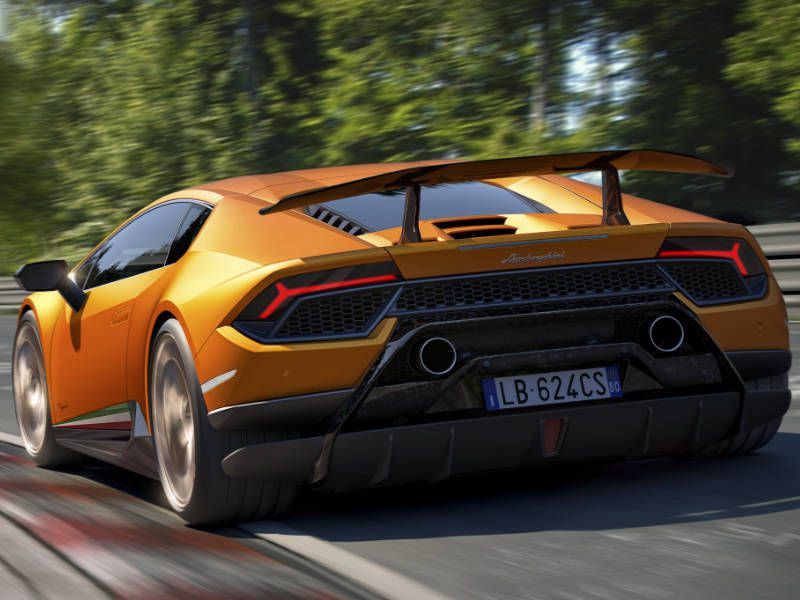
Photo by Lamborghini
Adjustable Dynamics
Every Huracan comes with Lamborghini’s ANIMA system, which offers three modes and allows the driver to customize the supercar’s dynamics to the conditions. The three modes — Strada, Sport and Corsa — are easily chosen with a toggle switch on the steering wheel. In Strada, or street, the Lambo is its most docile. Its transmission is fully automatic and Lamborghini says traction and stability are prioritized in this setting. On the track it was easy to find the limits of its electronic stability control. In Sport, the all-wheel drive system sends more power to the rear tires and the stability control system allows for some rotation. However, the car is still ready to help you drive better. The transmission will upshift for you, even in manual mode. In Corsa, or track, the gauge cluster changes to a larger tachometer and gear readout, the transmission is completely manual and the stability control allows for plenty of oversteer.
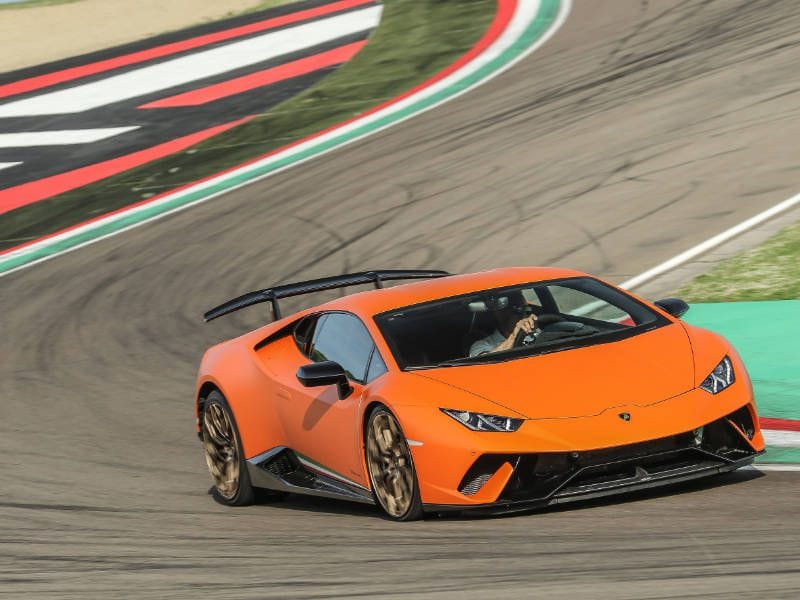
Photo by Lamborghini
Final Thoughts
Lamborghinis have never been more popular. The exotic Italian automaker, which was founded in 1963 by tractor magnate Ferruccio Lamborghini, sold a record number of cars last year: 3,457 globally. A little over 1,000 of those were in the United States and the majority of those were Huracans. It’s easy to understand why. This car is something special. It’s not only one of the coolest, fastest and best-performing cars you can buy at any price, but it’s also comfortable enough to drive every day. For those in the market for an exotic high-performance coupe or convertible, the 2018 Lamborghini Huracan is a very desirable overall choice.
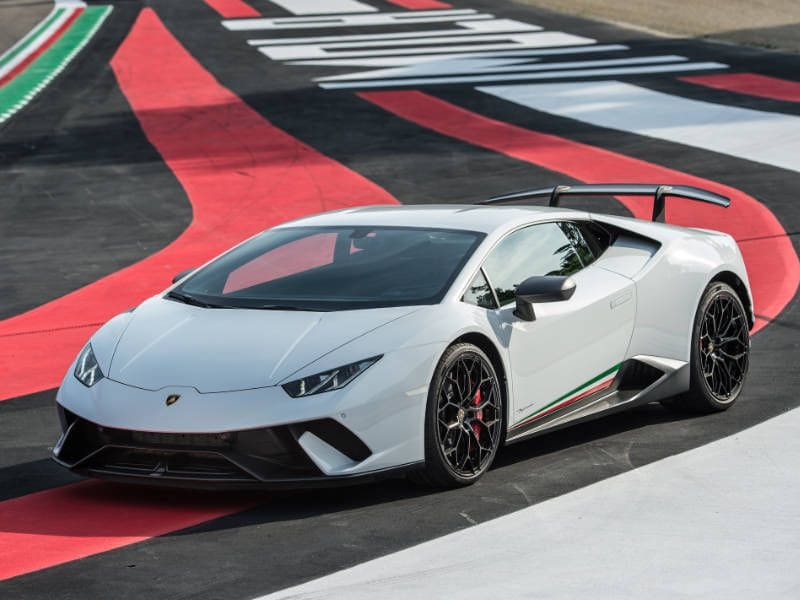
Photo by Lamborghini